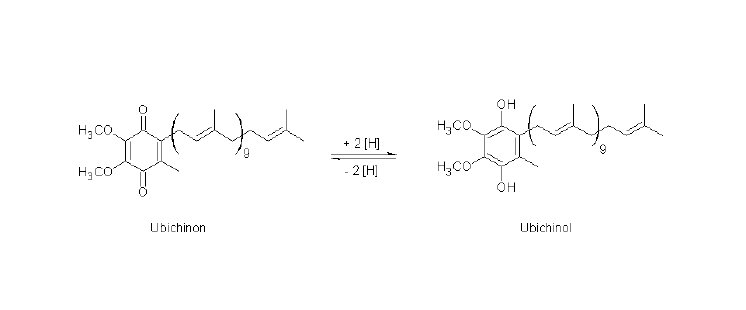Besides the taste, the durability, the appearance and above all, the health benefit effects of functional food are becoming ever more important. This trend began in 1993 with ACE juices and the range of products offered now is constantly growing. A new product concept is the enrichment of juices with coenzyme Q10. An existing successful application is the addition of coenzyme Q10 in the form of water-soluble formulations. The analysis and quantification of naturally lipid soluble coenzyme Q10, the so-called ubiquinone, represents a challenge.
Ubiquinone received its name due to the fact that it is an ubiquitous (lat. occurring everywhere) hydrophobic coenzyme found in membranes. It consists of a quinone ring and a side chain of 10 isoprene units. Essentially two important functions are fulfilled by ubiquinone in organisms:
The redox system ubiquinone-ubiquinol serves in the mitochondrial energy metabolism as an electron transporter. In addition, ubiquinone, due to the high number of double bonds in the side chain, is also a strong anti-oxidant which, while acting as a radical inhibitor, protects the membrane against lipid peroxidation during radical influences.
The human organism can synthesize ubiquinone itself. Additionally, coenzyme Q10 is supplied to the body through food. A sub-optimal supply is observed when there is a disturbance of the body-own synthesis or reduced incorporation caused by disturbed fat resorption or unilateral diets. Furthermore, a decrease of ubiquinone content in the body is generally observed with progressing age.
As analytical service provider in the field of biologically active substances such as vitamins and antioxidants, BioTeSys also offers the determination of coenzyme Q10 in physiological samples such as blood plasma, serum and cells, usually for manufacturers of pharmaceutical and cosmetic products as well as for dietary supplements. The samples are taken from clinical or in vitro tests and the bio-availability of the substances, nourish-physiological effects, absorption kinetics etc. are determined with modern methods of analysis.
With the increasing spread of functional food, the demand has also risen for accurate quantitative analysis of products containing coenzyme Q10, in particular in fruit juices. Acting on these market requirements, BioTeSys has developed a new analysis procedure for the determination of ubiquinone in fruit juices which has been tailored to the requirements of the sample preparation and their analysis. In order to determine, identify and quantify ubiquinone in the complex multi-component mixture which a natural juice represents, the juice is first extracted by a liquid-liquid extraction with the help of a non-mixable solvent mixture. The supernatant obtained from extraction is dried under a nitrogen stream at room temperature and stored in a defined volume HPLC eluent. The samples won this way can be separated by reversed-phase HPLC using in isocratic mode. Ubiquinone is detected by a UV detector at 275 nm wavelength.
In order to ensure the reliability and the precision also in cloudy fruit juices, an extensive validation of the analysis method optimised for fruit juices has been carried out. The analytical procedure is used in particular with juices available commercially. The quantification of ubiquinone content by BioTeSys enable to verify whether the coenzyme Q10-content promised in the advertisement actually remains during the period of shelf-life or whether it, during filling, transport and storage, comes to an unwanted deterioration. The procedure can also be extended and combined for the determination of further vitamins (vitamin A, E, ß-carotene) or any other quality relevant compounds.
Apart from the analytic question of the determination of ubiquinone in fruit juices, for the end customer - and also for the manufacturer - the detection of the bio-availability is of fundamental importance. Finally, the determination of the bio-availability of coenzyme Q10 from juices is the "proof of concept" as the absorption is the prerequisite for the effectiveness of coenzyme Q10. In this context, BioTeSys has specialized upon ascertainment of the bio-availability of biologically active contents during clinical studies. The study takes place under standardized conditions with a selected collection of probands.
Thus, BioTeSys offers the most modern technology and comprehensive know-how to its customer for solutions to questions and challenges in connection with the development of innovative functional products.
2 Figures
Legend:
FIGURE 1. Chemical formula representation of the ubiquinone (oxidized) - ubiquinol (reduced) - redox system.
FIGURE 2. HPLC separation of a ubiquinone standard (above) and a multivitamin juice (below) with 275 nm detection wavelength. Ubiquinone elutes after approximately 7,5 min and can be quantified without the disturbance of any impurities.

